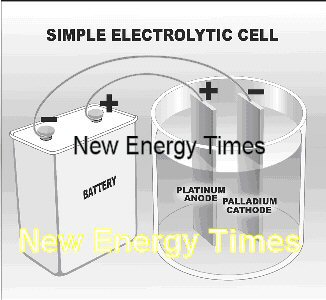One of the most common methods used to perform cold fusion experiments, (and that used by Fleischmann and Pons,) is that of electrolysis. Electrolysis is the process of passing an electrical current through a liquid, such as normal water (H2O), and separating the hydrogen atoms from the oxygen atoms. In the case of heavy water (D2O), deuterium atoms are separated from the oxygen atoms.
The basic cold fusion experiment is performed either in a small glass beaker, 250 milliliters in size, or in a narrow test tube, which can range from 20 to 100 milliliters in size. The difference in equipment varies based on the different methods of heat measurement employed.
In terms of its physical configuration and mechanical complexity, the apparatus is far less complex than the hot fusion apparatus. But a cold fusion electrolytic experiment is infinitely complex, deceptively so, on a smaller scale. Scientists must contend with a multitude of electrical, chemical, material science, metallurgical and time variables that all occur within the palladium cathode and the cell.
In the basic electrolytic cell, (Figure 1-2) an electrical circuit is made between the two poles of a battery and passed through a solution of liquid in a glass container. Two pieces of metal, or wires, are inserted into the container, one attached to the positive battery terminal, the other to the negative terminal.
Because pure water does not conduct electricity, the addition of salts to the liquid allows the electricity to flow through the solution, from one rod to the other. Lithium, in the form of LiOD, is a common salt used, as is potassium, in the form of K2CO3.
In a classical cold fusion electrolytic cell, platinum is usually connected to the positive terminal, palladium is usually connected to the negative terminal of the power source, and the heavy water solution is separated into its elemental components, deuterium and oxygen, by flow of current.
SIMPLE CONCEPTUAL DIAGRAM

Figure 1-2. Simple Electrolytic Cell.
(Drawing by Craig Erlick) |
SCHEMATIC DIAGRAM

Original diagram from 1990 Fleischmann-Pons seminal paper.
|

Photograph of Fleischmann-Pons
cold fusion cells. These are the cells
that they
actually used.
|

Photograph of a new cell configuration that Fleischmann and Pons had not tested yet. Newspapers photographed this cell because it was more "photogenic" than the cell to the left, according to Fleischmann.
Videotapes show Fleischmann and Pons holding this cell in their hands during the March 23, 1989, press conference. Other researchers modeled their cell geometry from the image of this cell, causing part of the responsibility of the failure to replicate.
|
|

